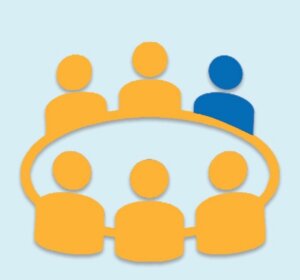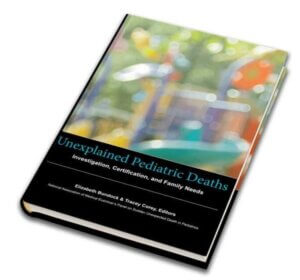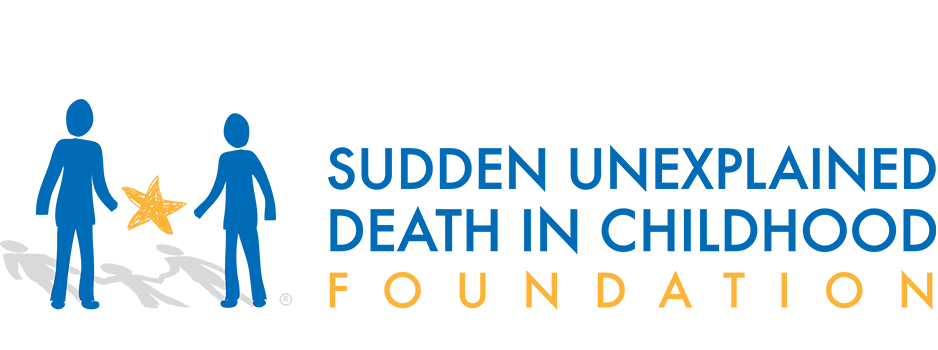23 Feb A Seat at the Table

The SUDC Foundation advocates for the needs of the SUDC community in many ways. One of the pillars of the SUDC Foundation’s mission is to “advocate for research.” We do this by funding critical research, performing research to better understand the needs of families affected, endorsing research to help other organizations solidify grant funds and by participating in related advocacy efforts. Recently, we released a video that summarizes our efforts called “How the SUDC Foundation Advocates for Research.” You can check it out here.
Participating in related advocacy efforts is perhaps the least recognized aspect in our efforts to advocate for research, but it is crucial. I wanted to take this opportunity to better explain why.
Historically, it is important to remember that SUDC was first defined in just 2005. Prior to this time, there were no concerted efforts to identify how often it happened or ways to predict or prevent it. Until the formation of the SUDC Program in 2001, the precursor to SUDC Foundation, there was no advocacy group dedicated to improving our understanding of SUDC nor caring for families affected. The first publication defining SUDC thus allowed us to embark on targeted efforts that had never existed before.
In the United States, we have a medicolegal death investigation system that is varied throughout the nation and under the direction of state laws. In 2009, the National Academy of Sciences issued an extensive report entitled “Strengthening Forensic Sciences in the United States: A Path Forward” which identified extensive areas of improvement needed to improve the quality of death investigations and the science that underlies it.
At first glance, this may seem displaced from SUDC, but all sudden and unexpected deaths fall under the jurisdiction of the local publicly mandated medicolegal death investigation where that child’s death occurred. If the SUDC Foundation is to impact our understanding of SUDC through research, we must start with a competent and thorough death investigation system that is collecting the evidence needed to understand these tragedies and advocate for those involved to ensure its success. Simply put – good research requires good data, and good data requires good investigations.
 Understanding SUDC also requires us to have a comprehensive understanding of the multi-agency system that investigates sudden and unexpected deaths and the medical system that cares for the families in its aftermath in order to achieve meaningful progress.
Understanding SUDC also requires us to have a comprehensive understanding of the multi-agency system that investigates sudden and unexpected deaths and the medical system that cares for the families in its aftermath in order to achieve meaningful progress.
To do this, SUDC needed a seat at the table. The advocates pioneering SUDC awareness knew if we weren’t involved with systemic progress, the needs of SUDC would not be addressed. And over the years, we have done just that. The work gives me the opportunity to be a part of initiatives which span state and federal legislative initiatives, federal working groups to improve the quality of the forensic sciences, and collaborations with professional groups to improve pediatric death investigations, research, forensic standards and the care of bereaved families.
I feel honored to have had a “seat at the table” to do my personal best to affect SUDC efforts and the many invaluable lessons I have learned along the way.
- Never underestimate what you don’t know and what you can learn from others – including those who disagree with your views. I have learned so much from these individuals and investing in understanding their perspectives has always made the end-product of our work together better for everyone. The same goes for sharing my own perspectives of my work in SUDC when working in a multidisciplinary setting. It shines a light on SUDC and the areas in need of change.
- The professionals who work in the area of medicolegal death investigation are usually underfunded and very overworked. As a society, we need to support them adequately if we want a quality system. Understanding their daily struggles has allowed me to become a better advocate, not only for SUDC families, but for the professionals who are charged with investigating child deaths. It is not a field many people choose to enter, but it is an essential and invaluable public service that affects our public health efforts and impacts our ability to practice preventative medicine.
- Moving the needle of progress, even just a little, is a success. Sometimes the road to our goal seems so far, so celebrating the small steps to get there helps create the energy to keep going.
- Working with all of the fellow volunteers on the below initiatives to improve the system and science of death investigation, was surrounding myself with people determined to make a difference for those who have suffered loss and tragedy and speaking for those who cannot. It has been a personal honor to work with these colleagues and get to know them.
Below is a partial list of the initiatives I have participated in, listed in order of occurrence. Other members of the SUDC Foundation are making progress by volunteering their time on child team review committees and similar efforts. Most of the initiatives were multiyear commitments and all of them were difficult and rewarding in their own unique ways. I am proud of the accomplishments thus far and ever grateful for the amazing colleagues who have educated me along the way and continue to do so today.
New Jersey’s Sudden Child Death Autopsy Protocol (2000-present), Member Created by New Jersey statute to improve pediatric death investigations (ages birth to 3 years), this multidisciplinary committee has continued to guide efforts since 2000.
CDC’s Revised SUIDIRF Form (2006)The SUIDIRF Form is used by medicolegal death investigation professionals in the United States when investigating the scene where an infant was found unresponsive. The framework of the SUIDIRF informed the creation of the child death investigation form in Unexplained Pediatric Deaths: Investigation, Certification and Family Needs detailed below.
Scientific Working Group for Medicolegal Death Investigation (SWGMDI) (2011-2014) SWGMDI was created with support from the National Institute of Justice through an Interagency agreement with the Federal Bureau of Investigations. This working group created the Guidelines for Communication with Next of Kin During Medicolegal Death Investigations and SWGMDI’s Report and Recommendations for Research in Forensic Pathology/Medicolegal Death Investigation.
North American SUDEP Registry (2014- present) Member, Executive Board SUDEP stands for Sudden Unexpected Death in Epilepsy.
National Association of Medical Examiners (NAME) (Member 2014-Present) Research Committee Member (2015-2016), Program Chair of National Association of medical Examiner’s Interim Meeting “UUUgh, the Unexpected, Undetermined and often Unexplained”, Las Vegas, NV, February 23, 2016.
NIH/CDC Sudden Death in the Young (SDY) Advisory Committee (2014-2016) Member The SDY Case Registry builds on child death review programs and uses the National Center for Fatality Review and Prevention’s Case Reporting System, to analyze information about the circumstances and investigations of sudden death in the young.
The Sudden Unexpected Death Data Enhancement and Awareness Act (H.R. 669) (2014) This legislation was signed into law by President Obama on December 18, 2014. Specifically, the Sudden Unexpected Death Data Enhancement and Awareness Act will build upon existing activities at the Center for Disease Control and Prevention (CDC) to improve the quality and consistency of data collected during the death scene investigations and autopsies to better inform prevention and intervention efforts related to stillbirths, Sudden Unexpected Infant Deaths (SUID) and Sudden unexplained Death in Childhood (SUDC).
National Forensic Science Commission (NFSC) (2015-2016) The Department of Justice (DOJ) established the NCFS as a Federal Advisory Committee, in partnership with the National Institute of Standards and Technology (NIST), to enhance the practice and improve the reliability of forensic science. This working group created Recommendations on Model Legislation for Medicolegal Death Investigation Systems and Views on Communication with Next of Kin and Other Family Members, which helped SUDC families by helping to promote standardization among states and further confirming the importance of thorough and sensitive communication with bereaved families. Other work products from the subcommittee on medicolegal death investigation can be found here.
Organization of Scientific Area Committees For Forensic Science (OSAC) (2014-2020) OSAC strengthens the nation’s use of forensic science by facilitating the development and promoting the use of high-quality, technically sound standards. The subcommittee on Medicolegal Death Investigation developed the Organizational and Foundational Standard for Medicolegal Death Investigation (under current review by standards developing organization), dozens of discipline specific baseline documents and identification of research and development needs in the system including Pediatric Forensic Pathology to Improve the Accuracy of Cause and Manner of Death Certification and Understanding the Genetic Risks of Sudden Death among others. Other work products from the subcommittee for medicolegal death investigation can be found here.

Unexplained Pediatric Deaths: Investigation, Certification and Family Needs (2016-2020) The path to production of this publication began in 2016 when the SUDC Foundation provided a scientific grant to the National Association of Medical Examiners to convene, in collaboration with the American Academy of Pediatrics, an expert panel to identify and discuss the diverse issues and limitations surrounding these deaths and build a foundation for national consensus.
3rd International Congress on Unexplained Deaths in Infants and Children (2018) The work resulted in a published report detailing four recommended(International Classification of Diseases (ICD)-11 categories of MH11, MH12, MH14, PB00-PB0Z) for classification, and explicit definitions and guidance were provided for death certifiers. A distinct category for children over the age of 1 was recommended (MH12). The conclusions will be submitted to the World Health Organization for inclusion in the upcoming ICD-11. Published article is entitled: Inconsistent Classification of Unexplained Sudden Deaths in Infants and Children Hinders Surveillance, Prevention and Research and published here.
The National Center for Fatality Review and Prevention (NCFRP) 10-part Death Scene Investigation Learning Series (2020) Partnering with NCFRP in this learning series to educate investigators about SUDC and encourage comprehensive data collection promotes quality investigations that lets us learn more about SUDC when it occurs. While everyone works hard to identify the cause of death when a child dies, we need investigators to know about SUDC, where they can refer families and where they can access research.
Scarlett’s Sunshine on Unexpected Death Act (2020) Scarlett’s Sunshine Act (H.R. 2271/S. 1130) strengthens efforts to better understand SUID and SUDC, facilitate data collection and analysis to improve prevention efforts, and support children and families.
__________
As the needs of our SUDC community evolve and our network of partners continue to grow, we will continue our work of advocating for research through such related advocacy initiatives. Such opportunities advance our understanding of SUDC through quality research and support a system that is critical to our collective public health and reaching a future free of SUDC.
 i
i


